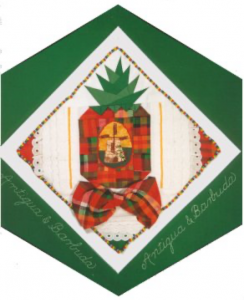Antigua and Barbuda

The Block
An Antiguan Black Pineapple, the national fruit once used for making twine, cloth, and for healing purposes, is the centre of the Antigua and Barbuda block. It is re-created in madras, a fabric used extensively for clothing and decorating. The design is the brainchild of Jody Savard Willie, inspired by Geri-Anne Seaforth and brought to life by Evelyn Burns.
Within the pineapple’s interior is an embroidered cane-processing windmill, which represents the historic sugar cane business that was once Antigua’s main industry. Today over 100 sugar mills still stand throughout the islands as a silent reminder of a time when sugar was “king”. At the base of the pineapple is a three-dimensional, madras bow tie, symbolic of the way in which Antiguan women tie the headdresses of their traditional costumes. The background consists of four layers of cotton eyelet lace used on aprons, which are also a part of the traditional dress. Colourful beads, similar to those used in necklaces worn by many Antiguan women, frame the piece.
Cultural Profile
Antigua and Barbuda (meaning ‘’ancient’’ and ‘’bearded’’) is an independent island nation state in the heart of the Caribbean and is part of the Leeward Islands. The three major islands are Antigua, Barbuda and uninhabited Redonda. As the islands were long British colonies, the official language is English, though most islanders speak a local patois, Antigua Creole.
Antigua, named after the Santa Maria la Antigua Church in Seville, Spain, by Christopher Columbus, is known as the ‘gateway to the Caribbean’. The port of Saint John’s, the capital and the archipelago’s largest city, is located on Antigua. The island is also home to the historic Nelson’s Dockyard, a natural harbour that was later turned into a dockyard and used by the British Navy in the 1700 and 1800s. Barbuda, formerly known as Dulcina, is a large coral atoll 40 kilometres to the north on which only two percent of the population lives but where there is a strong fishing industry.
Culture in both Antigua and Barbuda reflects a traditional West Indian character and is strongly rooted in the African traditions of the slaves who had been brought in to work the sugarcane plantations in the late 1600s. That influence is evident in the architecture, steel bands, calypso and reggae music, and in festivals such as the exuberant Carnival on Antigua and Barbuda’s Caribara. English traditions however, also play an important role. At Christmas, Antigua is illuminated by coloured lights. Costumes of brightly coloured batik, linen, cotton or silk are often worn during the nation’s many celebrations, and reflect the islanders’ exuberance and friendly, ‘full of life’ nature. The islands became independent in 1981 and islanders chose the madras textile as a symbol of their distinct identity. On National Dress Day, the madras used in the block is proudly worn by the islanders, draped as bunting on buildings and used everywhere possible. Some national crafts include embroidery, weaving, the making of straw items and wood carving.
Antiguans in Canada proudly preserve their heritage and values. Politeness to others, helping others, practicing the “Golden Rule”, using words to settle disagreements in a non-violent manner are core teachings that reflect the heart and nature of Antiguans. They are people of strong faith and community life includes active church going, a practice that reinforces these values.
Central to the culture of the islands is the cuisine. Coalpot, a ceramic vessel made on Antigua that uses live coals in it to cook the food, produces the smoky flavour that evokes the tastes of home. The famous Pepperpot, a stew of roasted meats, ochra and fungee, the salt fish, “chop-up’’, doucanna, plantain are all familiar foods shared in homes, restaurants and community events. As many people who came to Canada from Antigua and Barbuda settled in Ontario, the food, the music, the costumes and the madras are proudly in evidence each year at the exuberant Caribana Festival of Toronto. A 2011 census indicates that there are now over 3,600 Antiguans and Barbudans living here.
Sponsor: Knights of Columbus, St. Lawrence Council 5068
